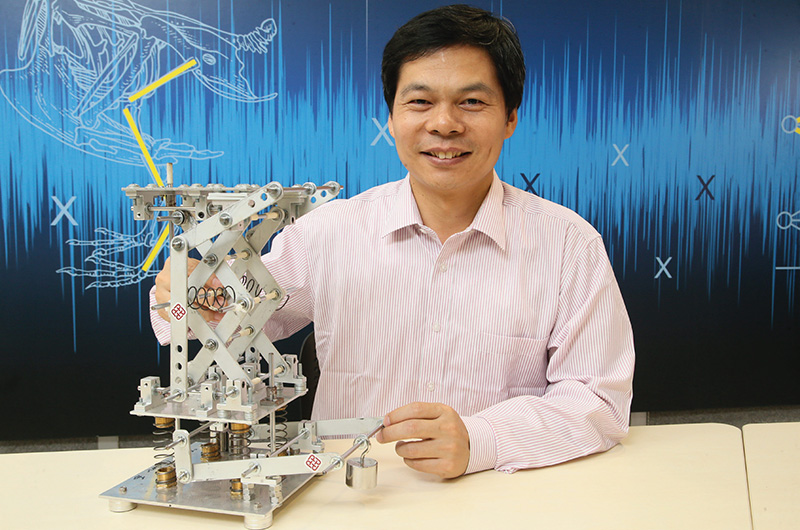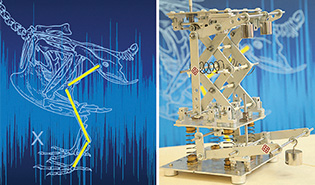
Dr Jing Xing-jian
PolyU’s breakthrough in anti-vibration technology can detect and suppress micro-vibrations in spacecraft and satellites.
In micro-gravity environments such as spacecraft, micro-vibration – low-level mechanical vibration often caused by mechanical systems such as thrusters, cryocoolers, and solar array drive mechanisms – can damage onboard instruments over time, for instance, decreasing the sensitivity and accuracy of telescopes and cameras.

The X-shaped anti-vibration structure developed based on the limb structures of birds in vibration control.
A research team led by Dr Jing Xing-jian from the Department of Mechanical Engineering has invented a bio-inspired nonlinear anti-vibration system that can reduce mechanical vibration dramatically, providing more reliable performance and cost-efficiency than any existing technology.
Vibration is usually controlled through two types of systems. Passive vibration control systems isolate or mitigate vibration through equipment such as rubber pads, shock absorbers and mechanical springs. In contrast, active vibration control systems apply equal force or energy in opposition to the vibration force. The less complex and more reliable passive systems are more commonly used in engineering practice because of their lower manufacturing, operating and maintenance costs, as well as their lower energy requirements. However, they do not control vibration as effectively as active systems.
Inspired by the limb structures of birds and insects with vibrational motion control, in particular, the woodpecker’s motion of hammering into wood hundreds of times a day without suffering concussion, the research team developed an X-shaped anti-vibration structure that combines the benefits of both passive and active systems. This technology demonstrates nearly zero response to any vibration, providing quasi-zero low dynamic stiffness while maintaining high loading capacity. The new structure also automatically provides high damping for strong vibration and low damping for small vibration, preventing high damping from damaging systems during small vibration. These advantages are due to the unique nonlinearity of the design, which enables it to be applied widely in various engineering applications and vibration control devices, such as precise machines, robotics, railways and offshore platforms, among many others.
With the support of the China Academy of Space Technology, the research team has applied this innovation in developing a passive microvibration control system that achieves zero-stiffness in the desired vibration suppression. In addition, the team has also developed a systematic and integrated method to identify important nonlinear features in time series data of vibration signals. This information is used in a novel virtual beam method that can locate and identify potential faults such as bolts loosening or cracks in various sub-hanging structures in satellites.
This innovation received a prestigious TechConnect Global Innovation Award in 2017. ♦
